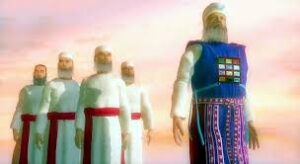The Selection of Aaron and His Sons as Priests
28: 1-5
The selection of Aaron and his sons as priests DIG: What was the purpose for the special garments for Aaron and his sons? Could they have done their job effectively without them? Why do you think so? How would each item and its color serve to dignify their role?
REFLECT: What priestly garments does your Messianic rabbi or pastor wear? Does he dress differently from the congregation? Why or why not?

Out of all countries, the Holy One, blessed be He, chose the Land of Isra’el, and from the Land of Isra’el He selected the Temple, and from the Temple, He selected only the Most Holy Place. Similarly, ADONAI selected Isra’el, and from Isra’el, He selecte the tribe of Levi, and from the tribe of Levi, He selected Aaron (Shemot Rabbah 37:4). YHVH said to Moshe: Have Aaron your brother brought to you from among the Israelites, along with his sons Nadab and Abidhu, Eleazar and Ithamar, so they may serve Me as priests (28:1). The priests who were to officiate in the ministry of the Tabernacle were Aaron and his four sons. Later Nadab and Abihu died when they brought strange fire to the altar of incense (Leviticus 10:1-2). As a result, the Aaronic priesthood continued through Eleazar and Ithamaar, his two younger sons. Eleazar succeeded his father as high priest (Numbers 3:4).
Make sacred garments for your brother Aaron, to give him dignity and splendor (28:2). The sacred garments for the high priest were set apart from common clothing to elevate the office and to give him dignity and splendor. This would serve as a constant reminder of God’s holiness.617 The garments were to be worn only when they served in the Tabernacle (35:19). Tell all the skilled men to whom I have given wisdom in such matters that they are to make garments for Aaron, for his consecration, so he may serve Me as priest (28:3). They were to be made by Bezalel and Oholiab and the other craftsmen to whom God had granted skill.
These are the garments they are to make: a breastpiece, an ephod, a robe, a woven tunic, a turban and a sash. They are to make these sacred garments for our brother Aaron and his sons, so they may serve Me as priests. There are several ways that the beauty of the priests’ clothing were displayed. For one thing, this passage mentions the remarkable embroidery, stitch work, weaving, and detailed handwork. But along with the skillful handwork, was the dying and combination of magnificent colors: gold, blue, purple, scarlet, and white. Those five colors were repeated several times in describing the Levitical priesthood.
Have them use gold: Which is the purest of all metals and is often used in connection with royalty. Thus, it shows that the high priest was to picture the priesthood as royal.
and blue: Which some consider to represent heaven, is also the same color as the tizitzit which the Eternal One tells Jews to wear on the four corners of their garments. There is no indication that the high priest had tizitzit sown into his clothes. But, he did have a long robe of blue. Therefore, the high priest was a walking reminder to follow the covenant, to live according to the ketubah (to see link click Dh – ADONAI and the Torah) – to follow the Torah.
purple: It’s a combination of blue and scarlet. To be honest, its symbolism is difficult to determine. Perhaps it prevents a glaring contrast between the blue and the scarlet.
and scarlet yarn: It is a color which is used to remind us of our human nature. The Hebrew word for red is the same word used for man, Adam. It is true that the Hebrew word in this parashah is not Adam, but the color is similar. It is close to red. By wearing scarlet, the high priest was representing mankind before the Holy One.
and fine linen: which represents purity (28:4-5)
They were to use the various colors of blue, purple and scarlet yarn used in construction of the Tabernacle, but with one significant addition. Strands of pure gold, cut from thin sheets of the precious metal (39:3), were to be worked into the fine linen from which the two main garments, the ephod and the breastpiece, were made. Thus, those five colors connected the high priest to the Tabernacle.



Leave A Comment